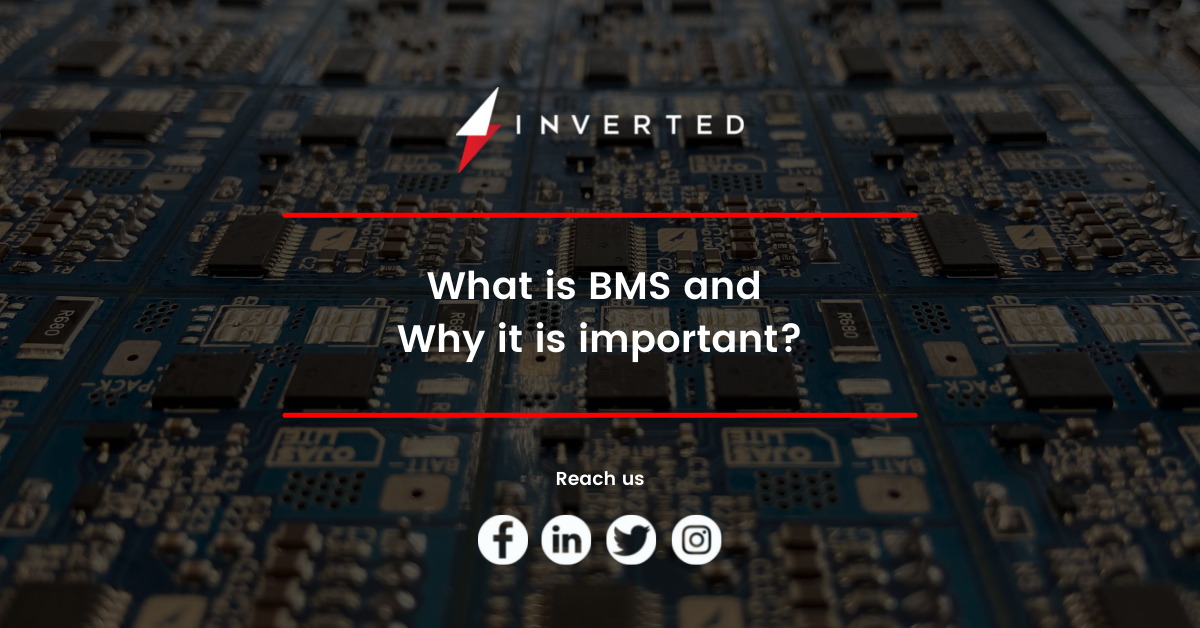
Battery Management System is responsible for the safety of the battery as it continuously monitors the parameters of the battery like temperature and voltage. Overheating and overcharging can lead to failure of battery or even worse can cause an accident. And this is why BMS is required.
The best thing about the BMS is that it can be customized as per the overall requirement of the system. Not only that smart BMS can be modified in the future as per the requirement.
At Inverted, we have developed our own BMS which are OJAS and VIDUR. VIDUR is a smart BMS. As per the customer requirements, it can be modified.
In technical terms, BMS provides information related to SoC & SoH which is the State of Charge and the State of Health.
SoC: Informs about the total capacity of the battery like how much power is left in the battery
SoH: Informs bout the health of the battery in terms of cell aging.
That data can be used to further enhance the safety and performance of the battery.
BMS helps to avoid the overcharging and over-discharging of the battery. What BMS does is that it maintains the charging level between the maximum and minimum allowed charging and discharging capacity of the battery. In other words, BMS is a very crucial device both for the safety of the battery and the user.
Main Functional Blocks of Battery Management System
- Cut-off FETs
- Fuel Gauge Monitor
- Cell Voltage Monitor
- Temperature Monitor
Cut-Off FETs
The FET driver act as an isolating section between the battery and charger.
- High-side activates NMOSFET using the charge pump driver.
- Low-side actives NMSOFET without charge pump driver.
Fuels Gauge Monitor
The fuel Gauge monitor tracks the charge entering and exiting the battery. The charge is calculated by multiplying current and time.
Cell Voltage Sensor
Cell Voltage Sensor is the standard function of the battery management system. It helps to see if all cells are operating at standard voltage levels while charging and discharging.
Temperature Monitoring
Temperature monitoring is a core functionality of the BMS. New and evolved batteries which are made can supply high currents. A sudden rise in current flow can cause a sudden rise in temperature which sometimes can be harmful to the battery.
To avoid any accident, BMS continuously monitors the temperature of the battery.
Apart from these basic functionalities, there are a few more functions available in the BMS.
- Battery Authentication: This function prevents the BMS system to be integrated with a 3rd party battery pack.
- Real-time Clock
- Memory to store logs and data
- Daisy Chain which simplifies the connections
If we talk about the functions of the BMS, there are 3 functions that we can say are common across all of the BMS boards out there in the market.
- Safety
- Battery Performance Optimization
- Health Monitoring and Diagnostics
In the market, there are various types of BMS available which are categorized into 1A, 2S, 3S to 20S. Here S stands for the number of cells like in Ojas is 4S and VIDUR is 3S to 16S
As lithium-ion batteries are getting improved, battery management systems are also evolving. Now we believe you know what BMS is and why it is very important.


Leave A Comment